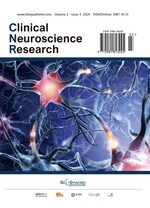Abstract
Objective: To analyze the impact of ambient temperature on the quantity of outpatient clinic visits for sleep disorders. Methods: Using data from sleep disorder outpatient visits in a large tertiary hospital in Hefei City, a distributional lag nonlinear model combined with a generalized Poisson regression model was used to analyze the relationship between ambient temperature and the number of outpatient visits for sleep disorders. Results: Ambient temperatures above 17.2℃ were found to be connected with a higher prevalence of sleep disorders visits, and that this relationship was most significant on day 8, which lasted for 7 days. For the single-day lagged impact, the maximum relative risk (RR) for moderate heat (75th percentile) was 1.077 (95% CI: 1.015–1.143). The cumulative lag effect was substantially greater than the single-day lag effect, with a maximum relative risk (RR) of 2.609 (95% CI: 1.306–5.212). The longest lag time was 14 days. The RR was similarly greater in women and those over 40. Outpatient visits for men with sleep disorders were not affected by ambient temperature in a statistically significant way. Conclusion: High ambient temperature raises the risk that patients will visit an outpatient facility and serves as a risk factor for sleep disorders. Patients who were 40 years of age or older and women were at vulnerability.
References
Hombali A, Seow E, Yuan Q, et al., 2019, Prevalence and Correlates of Sleep Disorder Symptoms in Psychiatric Disorders. Psychiatry Research, 2019(27): 116–122.
Masi A, Glozier N, Dale R, et al., 2017, The Immune System, Cytokines, and Biomarkers in Autism Spectrum Disorder. Neuroscience Bulletin, 33(2): 194–204.
Rao R, Vadiraja HS, Nagaratna R, et al., 2017, Effect of Yoga on Sleep Quality and Neuroendocrine Immune Response in Metastatic Breast Cancer Patients. Indian Journal of Palliative Care, 23(3): 253.
Durgan DJ, Bryan RM, 2012, Cerebrovascular Consequences of Obstructive Sleep Apnea. Journal of the American Heart Association, 1(4): e000091.
Caddick ZA, Gregory K, Arsintescu L, et al., 2018, A Review of the Environmental Parameters Necessary for an Optimal Sleep Environment. Building and Environment, 2018(132): 11–20.
Baaghideh M, Mayvaneh F, 2017, Climate Change and Simulation of Cardiovascular Disease Mortality: A Case Study of Mashhad, Iran. Iranian Journal of Public Health. 46(3): 396–407.
Cao T, Lian Z, Ma S, et al., 2021, Thermal Comfort and Sleep Quality under Temperature, Relative Humidity and Illuminance in Sleep Environment. Journal of Building Engineering, 2021(43): 102575.
Panmao Z, Rong Y, Baiquan Z, et al., 2017, Research Progress in Impact of 1.5C Global Warming on Global and Regional Scales. Advances in Climate Change Research, 13(5): 465.
Yu Z, Wei F, Wu M, et al., 2021, Association of Long-term Exposure to Ambient Air Pollution with the Incidence of Sleep Disorders: A Cohort Study in China. Ecotoxicology and Environmental Safety, 2021(211): 111956.
Mullins JT, White C, 2019, Temperature and Mental Health: Evidence from the Spectrum of Mental Health Outcomes. Journal of Health Economics, 2019(68): 102240.
Van Loenhout JAF, Grand AL, Duijm F, et al., 2016, The Effect of High Indoor Temperatures on Self-perceived Health of Elderly Persons. Environmental Research, 2016(146): 27–34.
Ebi KL, Capon A, Berry P, et al., 2021, Hot Weather and Heat Extremes: Health Risks. The Lancet, 398(10301): 698–708.
Jay O, Capon A, Berry P, et al., 2021, Reducing the Health Effects of Hot Weather and Heat Extremes: From Personal Cooling Strategies to Green Cities. The Lancet, 398(10301): 709–724.
Cepeda M, Koolhaas CM, Rooij FJAV, et al., 2018, Seasonality of Physical Activity, Sedentary Behavior, and Sleep in a Middle-aged and Elderly Population: The Rotterdam Study. Maturitas,2018(110): 41–50.
Okamoto-Mizuno K, Tsuzuki K, 2010. Effects of Season on Sleep and Skin Temperature in the Elderly. International Journal of Biometeorology, 54(4): 401–409.
Quante M, Wang R, Weng J, et al., 2019, Seasonal and Weather Variation of Sleep and Physical Activity in 12–14-year-old Children. Behavioral Sleep Medicine, 17(4): 398–410.
Obradovich N, Migliorini R, Mednick SC, et al., 2017, Nighttime Temperature and Human Sleep Loss in a Changing Climate. Science Advances, 3(5): e1601555.
Okamoto-Mizuno K, Tsuzuki K, Mizuno K, 2005, Effects of Humid Heat Exposure in later Sleep Segments on Sleep Stages and Body Temperature in Humans. International Journal of Biometeorology, 49(4): 232–237.
Minor K, Bjerre-Nielsen A, Jonasdottir SS, et al., 2022. Rising Temperatures Erode Human Sleep Globally. One Earth, 5(5): 534–549.
Gagnon D, Kenny GP, 2011, Sex Modulates Whole-body Sudomotor Thermosensitivity during Exercise. The Journal of Physiology, 589(24): 6205–6217.
